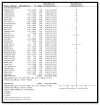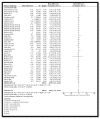Effects of Lifestyle Modification Interventions to Prevent and Manage Child and Adolescent Obesity: A Systematic Review and Meta-Analysis
- PMID: 32722112
- PMCID: PMC7468898
- DOI: 10.3390/nu12082208
Effects of Lifestyle Modification Interventions to Prevent and Manage Child and Adolescent Obesity: A Systematic Review and Meta-Analysis
Abstract
The objective of this review was to assess the impact of lifestyle interventions (including dietary interventions, physical activity, behavioral therapy, or any combination of these interventions) to prevent and manage childhood and adolescent obesity. We conducted a comprehensive literature search across various databases and grey literature without any restrictions on publication, language, or publication status until February 2020. We included randomized controlled trials and quasi-experimental studies from both high income countries (HIC) and low-middle-income countries (LMICs). Participants were children and adolescents from 0 to 19 years of age. Studies conducted among hospitalized children and children with any pre-existing health conditions were excluded from this review. A total of 654 studies (1160 papers) that met the inclusion criteria were included in this review. A total of 359 studies targeted obesity prevention, 280 studies targeted obesity management, while 15 studies targeted both prevention and management. The majority of the studies (81%) were conducted in HICs, 10% of studies were conducted in upper middle income countries, while only 2% of the studies were conducted in LMICs. The most common setting for these interventions were communities and school settings. Evidence for the prevention of obesity among children and adolescents suggests that a combination of diet and exercise might reduce the BMI z-score (MD: -0.12; 95% CI: -0.18 to -0.06; 32 studies; 33,039 participants; I2 93%; low quality evidence), body mass index (BMI) by 0.41 kg/m2 (MD: -0.41 kg/m2; 95% CI: -0.60 to -0.21; 35 studies; 47,499 participants; I2 98%; low quality evidence), and body weight (MD: -1.59; 95% CI: -2.95 to -0.23; 17 studies; 35,023 participants; I2 100%; low quality evidence). Behavioral therapy alone (MD: -0.07; 95% CI: -0.14 to -0.00; 19 studies; 8569 participants; I2 76%; low quality evidence) and a combination of exercise and behavioral therapy (MD: -0.08; 95% CI: -0.16 to -0.00; 9 studies; 7334 participants; I2 74%; low quality evidence) and diet in combination with exercise and behavioral therapy (MD: -0.13; 95% CI: -0.25 to -0.01; 5 studies; 1806 participants; I2 62%; low quality evidence) might reduce BMI z-score when compared to the control group. Evidence for obesity management suggests that exercise only interventions probably reduce BMI z-score (MD: -0.13; 95% CI: -0.20 to -0.06; 12 studies; 1084 participants; I2 0%; moderate quality evidence), and might reduce BMI (MD: -0.88; 95% CI: -1.265 to -0.50; 34 studies; 3846 participants; I2 72%) and body weight (MD: -3.01; 95% CI: -5.56 to -0.47; 16 studies; 1701 participants; I2 78%; low quality evidence) when compared to the control group. and the exercise along with behavioral therapy interventions (MD: -0.08; 95% CI: -0.16 to -0.00; 8 studies; 466 participants; I2 49%; moderate quality evidence), diet along with behavioral therapy interventions (MD: -0.16; 95% CI: -0.26 to -0.07; 4 studies; 329 participants; I2 0%; moderate quality evidence), and combination of diet, exercise and behavioral therapy (MD: -0.09; 95% CI: -0.14 to -0.05; 13 studies; 2995 participants; I2 12%; moderate quality evidence) also probably decreases BMI z-score when compared to the control group. The existing evidence is most favorable for a combination of interventions, such as diet along with exercise and exercise along with behavioral therapy for obesity prevention and exercise alone, diet along with exercise, diet along with behavioral therapy, and a combination of diet, exercise, and behavioral therapy for obesity management. Despite the growing obesity epidemic in LMICs, there is a significant dearth of obesity prevention and management studies from these regions.
Keywords: adolescents; children; interventions; obesity.
Conflict of interest statement
The authors declare no conflict of interest.
Figures















References
-
- The Global Nutrition Report. 2019 [cited 2020 05/06/2020] [(accessed on 10 May 2019)]; Available online: https://globalnutritionreport.org/
-
- Abarca-Gómez L., A Abdeen Z., Hamid Z.A., Abu-Rmeileh N.M., Acosta-Cazares B., Acuin C., Adams R.J., Aekplakorn W., Afsana K., A Aguilar-Salinas C., et al. Worldwide trends in body-mass index, underweight, overweight, and obesity from 1975 to 2016: A pooled analysis of 2416 population-based measurement studies in 128·9 million children, adolescents, and adults. Lancet. 2017;390:2627–2642. doi: 10.1016/S0140-6736(17)32129-3. - DOI - PMC - PubMed
Publication types
MeSH terms
Grants and funding
LinkOut - more resources
Full Text Sources
Medical
Miscellaneous

